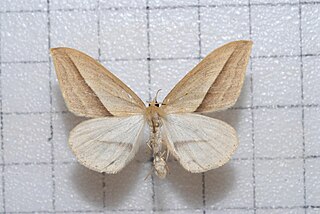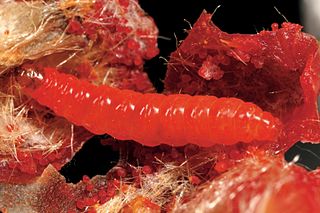
Lymantria dispar, also known as the gypsy moth or the spongy moth, is an Eurasian species of moth in the family Erebidae. Lymantria dispar is subdivided into several subspecies, with subspecies such as L. d. dispar and L. d. japonica being clearly identifiable without ambiguity. Lymantria dispar has been introduced to several continents and is now found in Europe, Africa, Asia, North America and South America. The polyphagous larvae live on a variety of deciduous and coniferous trees and can cause severe damage in years of mass reproduction. Due to these features, Lymantria dispar is listed among the world's 100 worst invasive alien species.

Ichthyornis is an extinct genus of toothy seabird-like ornithuran from the late Cretaceous period of North America. Its fossil remains are known from the chalks of Alberta, Alabama, Kansas, New Mexico, Saskatchewan, and Texas, in strata that were laid down in the Western Interior Seaway during the Turonian through Campanian ages, about 95–83.5 million years ago. Ichthyornis is a common component of the Niobrara Formation fauna, and numerous specimens have been found.

The large copper is a butterfly of the family Lycaenidae. L. dispar has been commonly arranged into three subspecies: L. dispar dispar, (single-brooded) which was commonly found in England, but is now extinct, L. d. batavus, (single-brooded) can be found in the Netherlands and has been reintroduced into the United Kingdom, and lastly, L. d. rutilus, (double-brooded) which is widespread across central and southern Europe. The latter has been declining in many European countries, due to habitat loss. Currently L. dispar is in severe decline in northwest Europe, but expanding in central and northern Europe.

Ichthyornithes is an extinct group of toothed avialans very closely related to the common ancestor of all modern birds. They are known from fossil remains found throughout the late Cretaceous period of North America, though only two genera, Ichthyornis and Janavis, are represented by complete enough fossils to have been named. Ichthyornitheans became extinct at the Cretaceous–Paleogene boundary, along with enantiornitheans, all other non-avian dinosaurs, and many other animal and plant groups.

Calosoma sycophanta, the forest caterpillar hunter, is a species of ground beetle belonging to the family Carabidae.

Heliactinidia is a genus of moths in the subfamily Arctiinae. The genus was erected by George Hampson in 1901.

Autoba is a genus of moths of the family Erebidae. The genus was erected by Francis Walker in 1863.
Tytroca is a genus of moths in the family Erebidae.

Crasilogia is a genus of moths in the family Geometridae described by Warren in 1903. It is sometimes considered a synonym of Costaconvexa.

Cyclophora is a genus of moths in the family Geometridae. Many species are referred to as mochas in reference to their colouration, primarily in Europe.

Loxaspilates is a genus of moths in the family Geometridae.

Rhodostrophia is a genus of moths in the family Geometridae erected by Jacob Hübner in 1823.

Eupitheciini is a tribe of geometer moths under subfamily Larentiinae, often referred to as pugs. The tribe was described by Tutt in 1896.
Carposina dispar is a moth of the family Carposinidae. It was first described by Lord Walsingham in 1907. It is endemic to the island of Hawaii.

Heliactinidia caerulescens is a moth of the subfamily Arctiinae first described by George Hampson in 1901. It is found in Colombia.

The Pericopina is a subtribe of tiger moths in the family Erebidae. The subtribe was described by Francis Walker in 1869.
Heliactinidia sitia is a moth of the subfamily Arctiinae. It was described by Schaus in 1910. It is found in Costa Rica.
Heliactinidia tornensis is a moth of the subfamily Arctiinae. It was described by Prout in 1918. It is found in Colombia.

Carposina is a genus of moths in the Carposinidae family.

The long-tailed shrew or rock shrew is a small shrew found in Atlantic Canada and the Northeastern United States.













